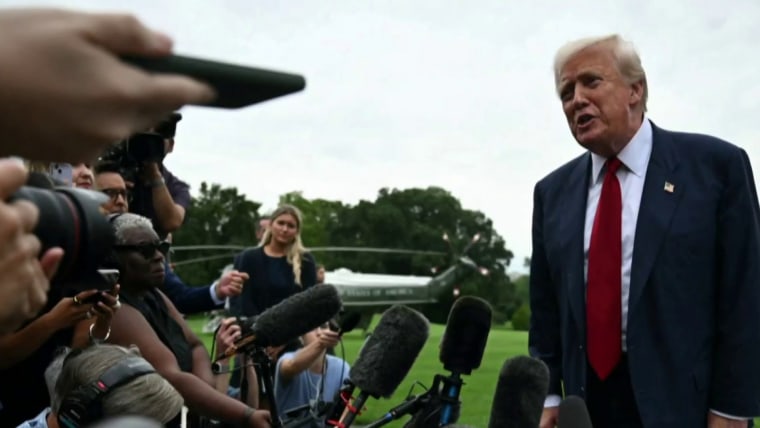The U.S. job market is suddenly looking far weaker than it did just a few weeks ago.
The U.S. added just 73,000 new jobs in July, the Bureau of Labor Statistics reported Friday, and deep revisions to the previous two months now indicate that the job market is considerably worse than previously thought.
The unemployment rate in July was unchanged at 4.2%, but more people left the labor force, according to the report. Payrolls have now averaged just 35,000 over the last three months — the weakest pace of job growth since the onset of the pandemic in 2020.
Jobs reports always contain revisions to previous months’ reports, with sizable revisions rare but not entirely uncommon. Last August, under the Biden administration, the Bureau of Labor Statistics said 818,000 fewer jobs had been created over a 12-month period than initially thought.
“Not only was this a much weaker than forecast payrolls number, the monster downward revisions to the past two months inflicts a major blow to the picture of labor market robustness,” Seema Shah, chief strategist with Principal Asset Management, said in a note following the release. “What’s more concerning is that with negative impact of tariffs only just starting to be felt, the coming months are likely to see even clearer evidence of a labor market slowdown.”
The report comes as President Donald Trump’s aggressive tariff policies are set to begin taking effect for many U.S. trading partners, a move that he has touted as a boost for U.S. labor but criticized by many experts as a tax on consumers.
Major U.S. stock indexes dropped sharply in early Friday trading, with the Dow losing more than 700 points, while the Nasdaq fell more than 2%. The broader S&P 500 was down about 1.7%, while yields on 10-year and 30-year U.S. bonds dropped, indicating a move by investors to safer assets.
The report comes a day after Trump unveiled a sweeping new set of tariffs. Analysts have calculated that the average effective tariff rate imposed on all goods being imported into the U.S. is now 15%, the highest level since the 1930s.
Despite uncertainty around tariffs in recent months, the U.S. economy had been largely seen as resilient, thanks in large part to jobs reports that appeared to show a strong rate of job creation.
That narrative shifted suddenly on Friday thanks in large part to revisions to the June and May reports. Revisions to jobs reports are not uncommon and are updated to reflect fuller data from state records. But the changes combined with July’s weak report offer a starkly different overall picture of the U.S. economy, which only added 19,000 jobs in May and June, rather than the 291,000 jobs the reports had initially found.
Most of the gains have been in health care — and without those, the last three months of jobs gains would have shown a net job loss in each of the last three months.
Friday’s job report will only increase the already considerable attention on the Federal Reserve and its economy-influencing interest rates.
Earlier this week, the Fed voted to keep interest rates steady, in part due to what Fed Chair Jerome Powell described as a solid jobs market. That pushed the odds of the next rate cut — something intensely desired by Trump — back to at least October.
But following the release of Friday’s jobs report, the odds of a September cut surged from about 40% to 80%.
The U.S. dollar index, which measures the dollar’s strength against other currencies, also plunged more than 1% on the report. A falling dollar makes it more expensive to import goods from overseas and raises the cost to Americans traveling abroad.
Two Trump-appointed members of the rate-setting committee who dissented from the Fed’s decision both released statements Friday before the report's release flagging the weakening labor market as a reason to cut rates.
Board Governor Christopher Waller said the jobs growth was operating at “near stall speed,” with other data suggesting further risks to the labor market had increased.
“With underlying inflation near target and the upside risks to inflation limited, we should not wait until the labor market deteriorates before we cut the policy rate,” he wrote.
Governor Michelle Bowman said the labor market is showing ”increasing signs of fragility,” with job gains “centered in an unusually narrow set of industries that are less affected by the business cycle, including health care and social services.”
Yet there are also signs that the price growth is accelerating, something analysts say puts the Fed, which is charged with keeping both unemployment and inflation low, in an increasingly difficult position.
“A turbulent week in markets and the economy is coming to a close with inflation moving higher, while economic and payroll growth are moving lower,” Daniel Hornung, a senior fellow at MIT and a former deputy director of the National Economic Council, said in a statement. “It’s a precarious position for the Fed and the economy, largely the result of the Administration’s stagflationary tariff policies, which are set to move even higher beginning next week.”
Prior to the report, Trump called on the Fed’s rate-setting board, which is largely composed of Biden appointees, to “assume control” if Powell continued to keep borrowing costs elevated. After the report Trump called Powell “a disaster.”
Historically, this kind of labor market weakness would tend to suggest interest rates should be lowered. Yet many analysts say the blame for the weakness itself lies with Trump and the uncertainty his policies have generated. Earlier this week, Trump administration officials sought to claim credit for a higher gross domestic product figure that analysts say was largely determined by one-off factors — inadvertently confirming the notion that Trump is responsible for the current climate.
“The Trump Economy has officially arrived,” Commerce Secretary Howard Lutnick wrote on X Wednesday.


